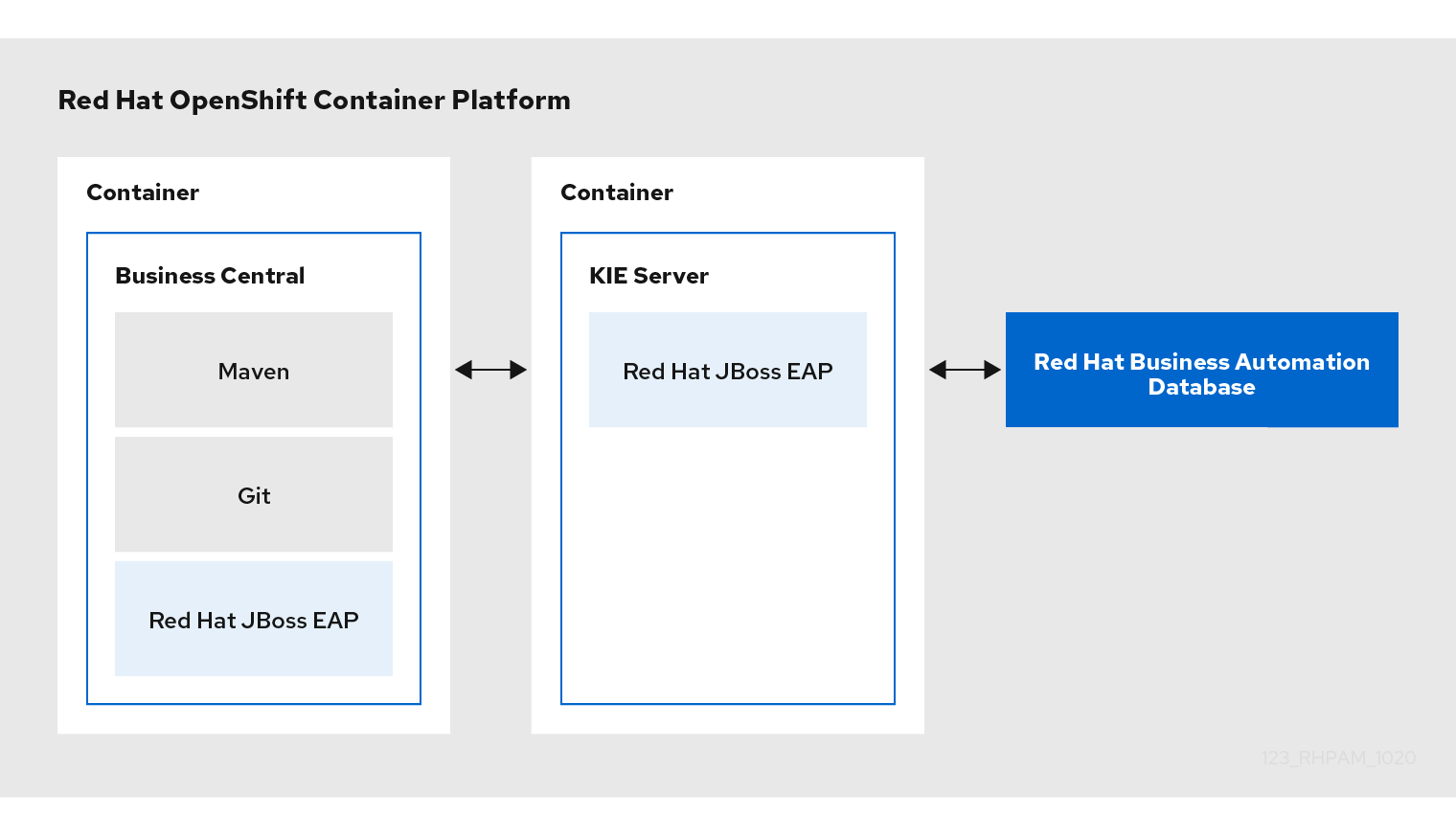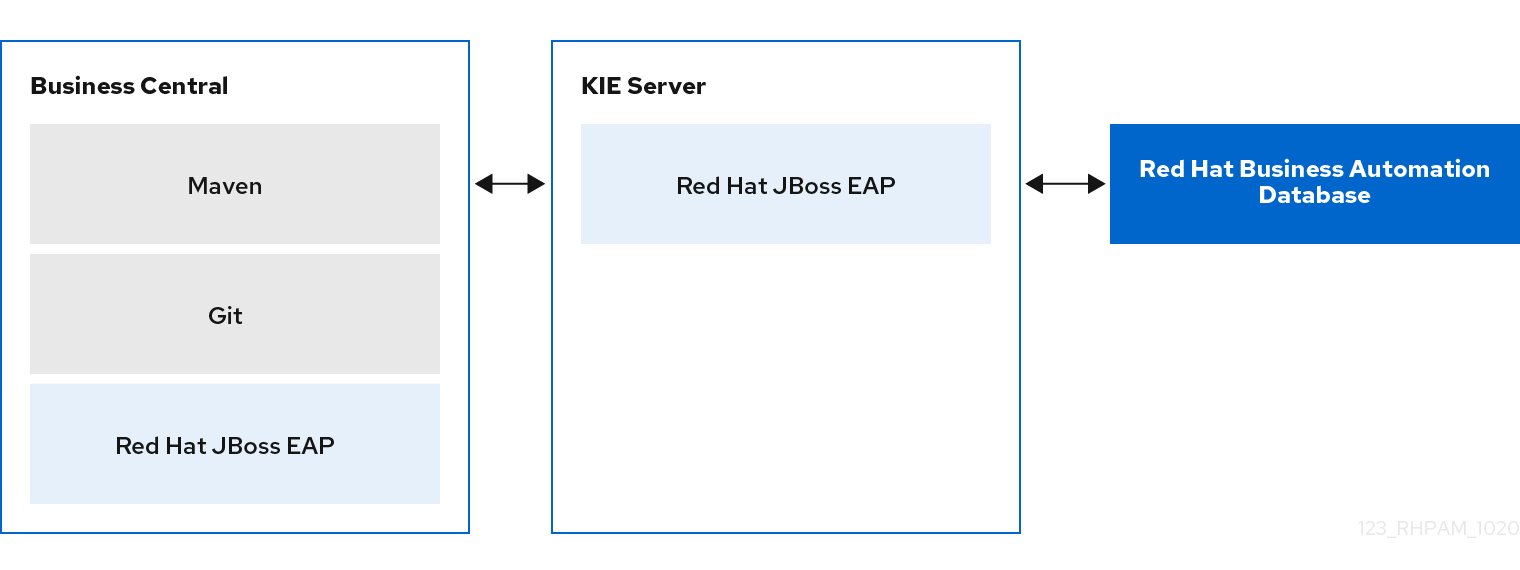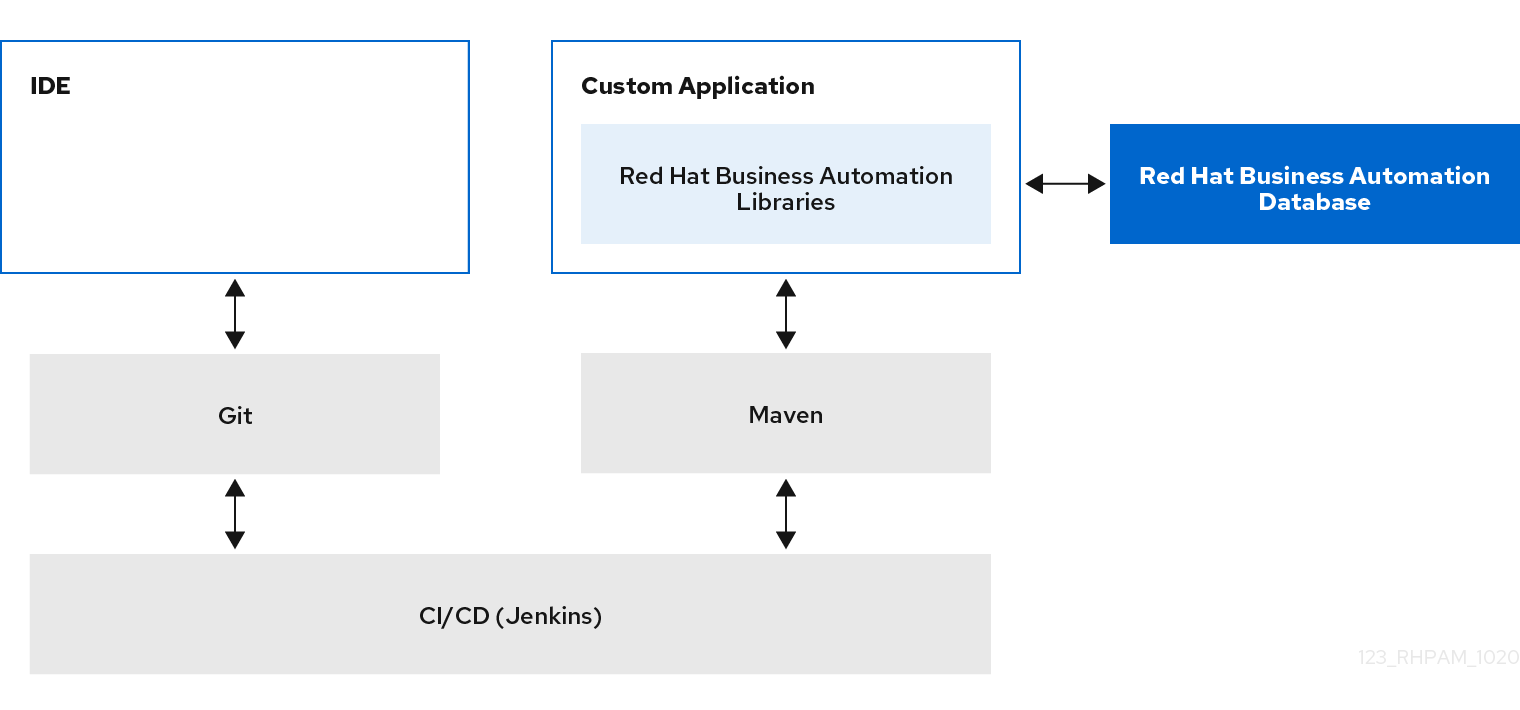Chapter 6. Example decision management architectures with Red Hat Process Automation Manager
The following scenarios illustrate common variations of Red Hat Process Automation Manager installation, asset authoring, project storage, project deployment, and asset execution in a decision management architecture. Each section summarizes the methods and tools used and the advantages for the given architecture. The examples are basic and are only a few of the many combinations you might consider, depending on your specific goals and needs with Red Hat Process Automation Manager.
- Red Hat Process Automation Manager authoring and managed server environments on OpenShift with Business Central and KIE Server
-
Installation environment: Red Hat Process Automation Manager on Red Hat OpenShift Container Platform, using the
rhpam711-authoring.yamlandrhpam711-kieserver.yamltemplate files - Project storage and build environment: External Git repository for project versioning synchronized with the Business Central Git repository using Git hooks, and external Maven repository for project management and building configured with KIE Server
- Asset-authoring tool: Business Central
- Main asset types: Decision Model and Notation (DMN) models for decisions and Business Process Model and Notation (BPMN) models for processes
- Project deployment and execution environment: KIE Server on Red Hat OpenShift Container Platform
Scenario advantages:
- Containerized implementation of Red Hat Process Automation Manager in a cloud-based development environment. Components of Red Hat Process Automation Manager are deployed as separate OpenShift pods that you can scale up and down individually, providing as few or as many containers as necessary for a particular component. You can use standard OpenShift methods to manage the pods and balance the load.
- Access to the repositories, assets, asset designers, and project build options in Business Central.
- Standardized asset-authoring approach using DMN and BPMN for optimal integration and stability.
- Access to KIE Server functionality and KIE APIs for asset deployment and execution.
Figure 6.1. Red Hat Process Automation Manager on OpenShift with Business Central and KIE Server

-
Installation environment: Red Hat Process Automation Manager on Red Hat OpenShift Container Platform, using the
- Red Hat Process Automation Manager on Red Hat JBoss EAP with Business Central and KIE Server
- Installation environment: Red Hat Process Automation Manager on Red Hat JBoss Enterprise Application Platform
- Project storage and build environment: External Git repository for project versioning synchronized with the Business Central Git repository using Git hooks, and external Maven repository for project management and building configured with KIE Server
- Asset-authoring tool: Business Central
- Main asset types: Decision Model and Notation (DMN) models for decisions and Business Process Model and Notation (BPMN) models for processes
- Project deployment and execution environment: KIE Server
Scenario advantages:
- Stable implementation of Red Hat Process Automation Manager in an on-premise development environment
- Access to the repositories, assets, asset designers, and project build options in Business Central
- Standardized asset-authoring approach using DMN and BPMN for optimal integration and stability
- Access to KIE Server functionality and KIE APIs for asset deployment and execution
Figure 6.2. Red Hat Process Automation Manager on Red Hat JBoss EAP with Business Central and KIE Server

- Red Hat Process Automation Manager on Red Hat JBoss EAP with an IDE and KIE Server
- Installation environment: Red Hat Process Automation Manager on Red Hat JBoss Enterprise Application Platform
- Project storage and build environment: External Git repository for project versioning (not synchronized with Business Central) and external Maven repository for project management and building configured with KIE Server
- Asset-authoring tools: Integrated development environment (IDE), such as Red Hat CodeReady Studio, and a spreadsheet editor or a Decision Model and Notation (DMN) modeling tool for other decision formats
- Main asset types: Drools Rule Language (DRL) rules, spreadsheet decision tables, and Decision Model and Notation (DMN) models for decisions, and Business Process Model and Notation (BPMN) models for processes
- Project deployment and execution environment: KIE Server
Scenario advantages:
- Flexible implementation of Red Hat Process Automation Manager in an on-premise development environment
- Ability to define business assets using an external IDE and other asset-authoring tools of your choice
- Access to KIE Server functionality and KIE APIs for asset deployment and execution
Figure 6.3. Red Hat Process Automation Manager on Red Hat JBoss EAP with an IDE and KIE Server

- Red Hat Process Automation Manager with an IDE and an embedded Java application
- Installation environment: Red Hat Process Automation Manager libraries embedded within a custom application
- Project storage and build environment: External Git repository for project versioning (not synchronized with Business Central) and external Maven repository for project management and building configured with your embedded Java application (not configured with KIE Server)
- Asset-authoring tools: Integrated development environment (IDE), such as Red Hat CodeReady Studio, and a spreadsheet editor or a Decision Model and Notation (DMN) modeling tool for other decision formats
- Main asset types: Drools Rule Language (DRL) rules, spreadsheet decision tables, and Decision Model and Notation (DMN) models for decisions, and Business Process Model and Notation (BPMN) models for processes
- Project deployment and execution environment: Embedded Java application, such as in a Java virtual machine (JVM) environment, microservice, or custom application server
Scenario advantages:
- Custom implementation of Red Hat Process Automation Manager in an on-premise development environment with an embedded Java application
- Ability to define business assets using an external IDE and other asset-authoring tools of your choice
- Use of custom APIs to interact with core KIE APIs (not KIE Server APIs) and to execute assets in the embedded engine
Figure 6.4. Red Hat Process Automation Manager with an IDE and an embedded Java application
